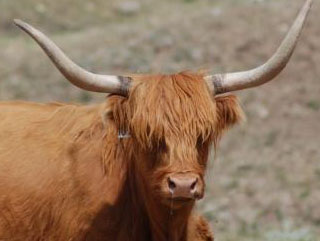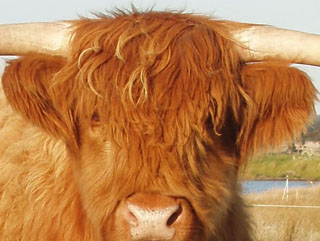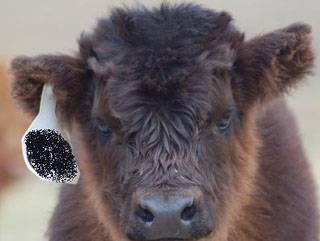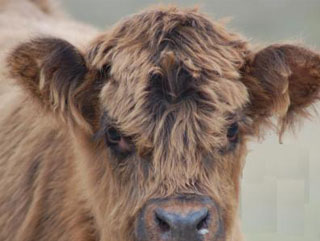At our 2019 AGM, the Crop Ear Committee suggested that the CHCS not take a stance on crop ear – and that was approved. Crop ear is a genetic trait in Highland cattle that simply affects ear shape. It does not affect the health of the animal or the quality of the meat. It is purely cosmetic.
After much research and discussion - it was felt taking a position that suggested an animal with crop ear was less desirable, no matter its other physical traits and blood lines, could have a serious and lasting impact on the diversity of the Canadian Highland gene pool.
Registered Highland offspring are already being lost to breeders who choose not to register their animals. We need to encourage breeders to maintain their registered animals, not add more fees or make it more complex. Any barriers to breeders with crop ear animals via registration constraints could result in a bias towards these breeders. Or worse, could result in breeders culling animals with great genetics for a cosmetic trait. That would be like punishing breeders for their animal’s hair colour, the conformation of their horns or the length of their tails.
Highland breeders have been doing an excellent job managing crop ear for hundreds of years; we feel those decisions should stay in the hands of individual breeders. There are genetic tests available to aid in those breeding decisions and breeders can contact their preferred genetic testing company to see if they are able to assist. A number of pilot diagnostic tests have performed at the laboratory CHCS uses, and a fee has been established. If a different facility is used there may a separate set-up fee.
The CHCS strongly encourages breeders to be knowledgeable and upfront in their business dealings.
A certain amount of responsibility and due diligence must remain with the purchaser of an animal to make themselves aware of what they are purchasing and ask the right questions, including physically checking ears as they check for the tattoo numbers. Do keep in mind that crop ear presentation varies in extremes and is very occasionally not physically detectable.
The CHCS will continue to provide education materials on this matter, so that new breeders are aware.
The following article regarding the genetics of crop ear is reproduced with the kind permission of Glen Hastie. You can view the original article here: http://www.bairnsley.com/Crop%20Ear.htm
THE GENETICS OF CROP EAR
This article will attempt to give a description of how the genes work that give rise to crop eared animals and to postulate some explanations as to discrepancies on the subject. The important genetic facts in this explanation are taken from the scientific paper referred to at the end of this article. The writers used information gathered from 548 stud book Highlands on 15 different farms in Germany.
General Concepts
This research has suggested that this ear defect is inherited by a single autosomal dominant gene, however there is incomplete dominance. ‘Autosomal’ means not sex-linked and ‘incomplete dominance’ refers to the fact that animals with the gene will show varying degrees to which they are affected. Some will be so severe that the external ear is barely recognisable and some so mild that the notch in the ear is barely noticeable.
The nomenclature that will be used in this article is the standard nomenclature that is used in all genetics. In this article we will call the gene for crop ear ‘C’ and the small letter ‘c’ will be the gene for normal ears. All animals will have two genes for ear shape - one derived from their dam and one derived from their sire. This is the same as all autosomal genes.
Only animals with two genes for normal ears (‘cc’) will have normal ears. An animal with one or two genes for crop ear (‘CC’ or ‘Cc’) will have crop ear. This is the case with all dominant genes. Crop ear is dominant over normal ears.

Crop Eared Cow

Normal Eared Cow

Crop Eared Calf

Normal Eared Calf
The Possible Genetic Combinations
CC
- These animals will have crop ear (the most severe form).
- These animals will pass the gene on for crop ear to their offspring - guaranteed. All of their calves should have some degree of crop ear.
- These animals MUST have received one dominant gene (C) from their sire and one from their dam. (i.e. both of their parents must have had crop ear).
Cc
- These animals should also have crop ear but these are the ones that account for the variation in severity. Some will be severe (although none quite as severe as CC animals), and some mild.
- These animals have a 50:50 chance of passing the dominant gene for crop ear (C) onto their offspring.
- These animals must receive the dominant gene (C) from one parent, and the recessive gene (c) from the other parent.
cc
- These animals CAN NOT have crop ear. All animals in Australia should be like this.
- Because these animals only carry the recessive gene 'c', they can not possibly give rise to an animal with crop ear when bred to each other.
An interesting way to look at it is with all the possible matings involving these genes.
Table - Genetic Combinations of Possible Matings
|
|
CC |
Cc |
cc |
|
CC |
100% CC |
50% CC 50% Cc |
100% Cc |
|
Cc |
50% CC 50% Cc |
25% CC 50% Cc 25% cc |
50% Cc 50% cc |
|
cc |
100% Cc |
50% Cc 50% cc |
100% cc |
| CC bred with CC |
all offspring should have crop ear - 100% of offspring will be CC (affected with severe crop ear) |
| CC bred with Cc |
all offspring should have crop ear - 50% will be CC (severe crop ear) and 50% will be Cc (still crop ear but variable degrees) |
| CC bred with cc |
all offspring should have crop ear - 100% will be Cc (variable degrees of crop ear, but none should be clear of it) |
| Cc bred with Cc |
¾ of offspring should have crop ear (25% CC, 50% Cc), and ¼ will be free of it (25%cc) |
| Cc bred with cc |
½ of offspring should have crop ear - 50% Cc (variable crop ear), 50% cc (no crop ear) |
| cc bred with cc |
all offspring will be free of crop ear. |
Facts We can Derive
According to this data:
| ► | You should never get crop ear in a calf bred from two animals that are genetically free of crop ear. |
| ► | If a calf is born with crop ear, then at least one of the parents MUST have had a gene for crop ear (‘C’). |
As I have just said, a crop-eared calf must have at least one parent with at least one crop ear gene (Cc or CC). We can not say that an animal with a crop ear gene will always have visible crop ear though.
Possible explanations for crop eared calves that come from supposed crop ear free animals include:
- (i) One of the parents has mild crop ear (a very small notch) that was not detected. Highlands with very mild crop ear will not be picked up purely on a visual basis. You need to palpate the ears very carefully or even clip the ears to be sure.
- (ii) One parent has ears that are smaller than normal but they have no notches (this may be another variation of the Cc animals). This has been reported anecdotally to occur in animals that have crop-eared offspring.
- (iii) There is a very small percentage of animals with one gene for crop ear (Cc) that have normal ears (no notch and a normal size overall).
- (iv) Incorrect parentage identification. Meaning that the recorded parents are not the real parents of the calf.
- (v) A mutation in the calf’s genetic make up. This would be possible but would be an extremely rare event.
Reference
1) "A non-coding genomic Duplication at the HMX1 locus is associated with Crop Ears in Highland Cattle."
by T Koch, R Bruggmann, J Tetens, & C Drogemuller.
PLOS One (October 23, 2013)
2) "Inheritance of notched ears in Highland cattle"
by A. Scheider, P. Schmidt and O. Distl,
Berl Munch Tierarztl Wochenschr. 1994 Oct; 107(10): 348-352

